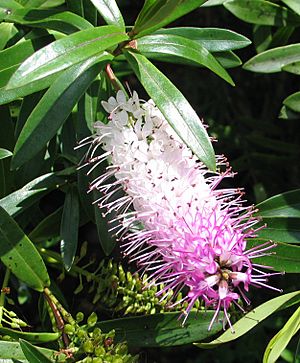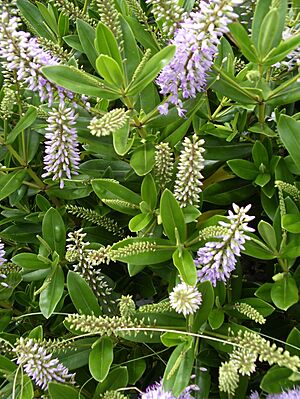New Zealand hebe facts for kids
Quick facts for kids Hebe speciosa |
|
|---|---|
 |
|
| Scientific classification | |
| Kingdom: | |
| (unranked): | |
| (unranked): | |
| (unranked): | |
| Order: | |
| Family: | |
| Genus: |
Hebe
|
| Species: |
H. speciosa
|
| Binomial name | |
| Hebe speciosa (A.Cunn) J.C.Andersen
|
|
| Synonyms | |
|
Veronica speciosa |
|
Hebe speciosa is a beautiful flowering plant that belongs to the plantain family. People often call it the New Zealand hebe or showy hebe because of its bright flowers. In New Zealand, where it originally comes from, the Maori people call it Titirangi or Napuka. You can find this plant growing in gardens all over the world because it's a popular ornamental plant, meaning it's grown for its looks.
What Does it Look Like?
This hebe plant is a type of shrub, which is like a large bush. It can grow to be about one to two meters tall, which is roughly the height of a grown-up. Its leaves are always green, so it's called an evergreen plant. They are dark green, shiny, and quite thick, usually about 2 to 5 centimeters long.
The flowers grow in a cluster called an inflorescence, which can be up to 8 centimeters long. These clusters are packed with flowers that range from pale pink to bright magenta. Each flower is small, less than a centimeter wide. It has a short tube that opens into four petal-like parts, called a corolla. Two long parts, called stamens, stick out from each flower. This makes the whole flower cluster look a bit like a whisk or brush. After the flowers, the plant grows a small fruit called a capsule, which holds flat, smooth seeds.
Growing Hebe Plants
Hebe speciosa and its many different types (called cultivars and hybrids) are very popular garden plants. People love to grow them in places with mild weather, like parts of southern Britain. They are liked because their leaves stay green all year, their flowers are very colorful, and they bloom for a long time. Plus, they are quite easy to take care of!
Some popular types of Hebe speciosa include 'Alicia Amherst', which has purple flowers, and 'Simon Deleaux', which has deep pink flowers. There are also many hybrid hebes, which are created by mixing two different types of plants. For example, 'Andersonii' is a hybrid of Hebe salicifolia and Hebe speciosa. Another hybrid, Hebe × franciscana, includes types like 'Blue Gem' and 'Waireka'.
Scientists sometimes change how they group plants. For a while, some thought that all Hebe plants should be called Veronica again, which was their original name. But newer research suggests that groups like Hebe should stay separate.
Fire Safety with Hebe Plants
Hebe speciosa is known for being a plant that doesn't catch fire easily. Because of this, the fire service in Tasmania suggests it as a good plant to grow near buildings. This means it can help protect homes in areas where there's a risk of fire.


